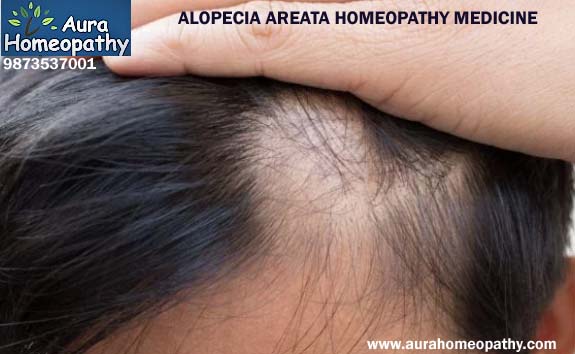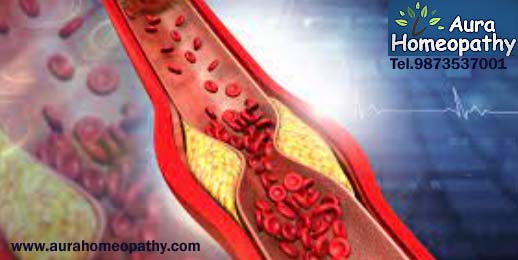Home / All Post / Best Homeopathy Medicine for Alopecia Areata Treatment
Best Homeopathy Medicine for Alopecia Areata Treatment

Best Homeopathy Medicine for Alopecia Areata Treatment
Aura Homeopathy treatment call for stringent individualization. So do not take Homeopathy medicine for Alopecia Areata without consulting your homeopath.
What is Alopecia Areata?
Areata alopecia is characterized by sudden hair loss in round patches that create bald areas. It is a highly unpredictable skin disease that can occur on the scalp and other parts of the body.
Causes of alopecia areata?
Alopecia Areata is an autoimmune disease. Hairloss generally originates with one or few smaller bald patches on the scalp which can headway into total hairloss on the scalp.
Differential Diagnosis of Alopecia Areata?
As per Dr. Abhishek Kasana (Veteran Homeopathic Doctor In India) a number of diseases conditions can lead to alopecia areata. In order to find Best Homeopathy Medicine for alopecia areata there are few prerequisites like Proper examination, lab test, case history record are supportive finding the correct diagnosis. Many disease can cause Alopecia. Few common causes are: anagen effluvium, alopecia areata, androgenetic alopecia, telogen effluvium, traction alopecia, and trichotillomania. Endocrine disorders such as hypoparathyroidism, hypothyroidism, and Cushing's syndrome along with malnutrition and toxic effects of some medications can cause alopecia.
Differentiating Alopecia from Other Diseases
Androgenetic Alopecia
Male pattern: The frontal hairline is thinner, hair loss occurs at the crown of the scalp, hair recession is seen at the temporal aspects of the scalp; Female pattern: Hair loss occurs at the crown of the scalp, however, the frontal hairline remains preserved.
Diagnosis is mostly clinical and is based on the pattern and absence of other explanations.
Unlike in telogen effluvium, hair pull test shows a less than 20% telogen count.
It is the most common cause of hair loss.
Alopecia Areata
It presents with round patches of total hair loss with retained follicular ostia with the beard and scalp being the most frequently affected areas.
Close observation reveals the characteristic exclamation mark hairs. A hair pull test followed by trichogram shows telogen and pencil point shafts.
It is associated with several autoimmune diseases including thyroid disease, rheumatoid arthritis, inflammatory bowel disease, and vitiligo.
Telogen Effluvium
There is a massive amount of hair shedding that is triggered by physiologic or psychologic stress.
Although considered to be a relatively common condition, the precise prevalence of telogen effluvium remains unknown. However, it is believed that it is more commonly seen in females than in males
Hair pull test followed by trichogram reveals numerous clubbed-shaped hairs; telogen count must exceed 20% for diagnosis.
It could be an acute self-limiting form triggered by stressors such as crash diets, childbirth, febrile illness, or psychological stress.
It may be chronic and present in association with female pattern hair loss.
Anagen Effluvium
There is diffuse hair loss and it is characterized by hair breakage that takes place in the anagen phase.
Associated with exposure to radiation, as in radiotherapy and cancer chemotherapy.
Trichoscopy would reveal the characteristic narrowing, fractured hair shafts with an absence of bulbs.
Trichotillomania
Presents with uneven broken hairs in the most frequently selected areas which are the scalp, eyebrows, eyelashes, body hair, facial hair, and pubic hair.
It usually starts around the age of 12–13 years
It is more common in males during the childhood years while it is more common in females in the adult years.
Scalp inspection reveals uneven patches of hair loss with broken hairs that remain well attached to the skin.
A characteristic finding that distinguishes trichotillomania from alopecia areata is that the affected areas are not totally devoid of hair shafts.
It occurs as a result of a lack of impulse control in which an individual pulls on hair.
Traction Alopecia
Hair loss at regions of the scalp exposed to tension on hair follicles for a prolonged period of time in people who make tight hairstyles.
Traction alopecia is seen in about 18,000 per 100,000 girls between the ages of 5.4 to 14.3 years based on a study of African-American girls.
Mostly a clinical diagnosis based on hair loss at areas of the scalp where tension on the hair is highest.
Early detection and switching to more loose hairstyles may reverse the condition, however, with prolonged tension on the scalp destruction of the hair follicles will occur, causing the condition to become irreversible.
Chronic Cutaneous Lupus Erythematosus
Presents with an area with hair loss that gradually converts into scaly, thickened papules then into poorly-defined, variably-shaped plaques with atrophy, follicular plugging, telangiectasia, and depigmentation.
Histological analysis after a hair pull test reveals a higher anagen count during active disease.
Direct immunofluorescence may reveal granular C3 and IgG at the dermo-epidermal boundary which is found in greater than 70% of cases.
Tinea Capitis
Presents in diverse ways such as ordinary scaling without any obvious hair loss which is considered to be a seborrheic form, a crusted or pustular form that may be localized or diffuse, a ‘black dot’ type that is characterized by tiny black dots within regions of alopecia, an inflammatory mass called kerion, and a round, bald, scaly patch where the follicular ostia are filled with keratinous debris.
A unique feature of tinea capitas is the presence of post-auricular and cervical lymphadenopathy.
It is more common in the pediatric population.
Potassium hydroxide preparation can be added to skin scrapings of affected areas in order to diagnose the condition.
Wood's light can also be used in diagnosis as majority of Microsporum spp will appear bluish-green, occasionally dull yellow (Microsporum gypseum) and dull blue (Trichophyton schoenleinii).
Possible complications of tinea capitas are kerion, an abscess in the scalp, or favus, another inflammatory form in which there is honeycomb destruction of the hair shaft. Both are severe forms of the disease and can cause permanent scarring.
Signs and symptoms of Alopecia Areata clinical presentation varies recurring, small round patch of hair loss to chronic loss, total nonscarring of scalp hair, eyebrows, eyelashes, nose, beard and body, spon remissions taneas can see.
Areata alopecia can be psychologically painful. The hair loss patch is due to an unknown trigger.
Increased prevalence of link with other autoimmune diseases such as vitiligo or Hashimoto's thyroiditis has been testified.
Investigation in the case of Alopecia Areata complete history and physical examination are important tools for diagnostic purposes; organ-specific antibodies can be demonstrated. Scalp biopsy can be useful in ruling out another disorder.
Alopecia Areata Treatment: A verity of treatment options is available for this condition, if the patch identifies small hair loss, it is best to wait and allow the hair to re-grow on its own. Other treatment options mainly include: application of strong topical steroids, a steroid injection, minoxidil has been used to promote hair growth and has shown limited results in few cases.
Another type of treatment is designed to produce contact dermatitis, or irritation, at the site of hair loss, to stimulate hair growth. Chemotherapy can also be useful in these cases.
Homeopathic treatment of Alopecia Areata:
Homeopathy is one of the most popular holistic systems of medicine. Remedy selection is based on the theory of individualization and symptom similarity through the use of holistic approach. This is the only way through which you can recover by removing all the signs and symptoms that the patient is suffering from a complete state of health. The aim of homeopathy is not only for the treatment of areata alopecia, but to address its underlying cause and individual susceptibility. With regard to therapeutic drugs, several remedies are available for the treatment of alopecia areata that can be selected on the basis of cause, sensations and modalities of claims. For individualized remedy selection and treatment, the patient should consult Best Homeopathy Doctor in India for Alopecia Areata.
Few Best Homeopathy Medicine For Alopecia Areata Treatment, there are remedies that are useful in the treatment of alopecia areata:
Ferrum phos – hair loss of the head due to anemia
Acidum flour – alopecia of the elderly or a premature aging due to syphilis, hair loss in patches, hair loss due to Sepia typhoid fever - hair fall during pregnancy, in circles like tin, dandruff dandruff scalp - hair falls in lactating women, when well-selected medicines fail to relieve.
Selenium met – hair loss from head, eyebrows, eyelashes and other part of the body
Natrum Mur – hair loss after childbirth, from a child his nursing, hair loss after chronic headaches Mancinella – hair loss after an illness acute severe
Vinca minor – hair loss, strong and well-defined, circumcised patches that leave the scalp soft and white or gray hair can grow in bald areas like white wool.
Phos Acid – Remarkable Remedy for Alopecia Areata, Hair Fall After Grinding Illness.
Sphingurus Mar Eyebrows & Eyelashes.
Lachesis beard hair fall
Carbo veg pregnancy - hair fall during pregnancy
Refrence:
WikiDocks : https://www.wikidoc.org/index.php/Alopecia_differential_diagnosis
Homeopathy Doctor In India For Alopecia Areata
Recent Post
ORDER TREATMENT ONLINE
Our Homeopathy treatment is now just a few clicks away.
Learn More...
Select your disease (s)
(Treatment for additional diseases charged at 50%)



